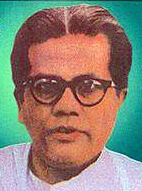Introduction
Lachit Borphukan is one of Assam’s most celebrated warriors, known for his unmatched bravery and leadership in the Battle of Saraighat. He played a key role in defending Assam from Mughal invasions and ensured that the Ahom Kingdom remained unconquered. His strategic brilliance and deep sense of patriotism set him apart from other warriors of Indian history.
Early Life and Background
Lachit Borphukan was born in December 1622 to Momai Tamuli, who later became the Borbarua (Governor of Upper Assam and Commander-in-Chief of the Ahom army). His father’s high position allowed Lachit to receive an excellent education in humanities, scriptures, and military science. As he grew older, he was entrusted with various important administrative and military responsibilities in the Ahom kingdom.
Before becoming the Supreme Commander, Lachit held multiple high-ranking positions, including:
- Superintendent of the Royal Horses (Ghora Barua)
- Commander of Simulgarh Fort
- Superintendent of the Royal Household Guards (Dolakasharia Barua)
- Scarf-bearer (Soladhara Barua) of the Ahom King (a role equivalent to a private secretaryship)
His journey from these roles to becoming the Commander-in-Chief of the Ahom army was marked by dedication, discipline, and loyalty to his motherland.
Appointment as Commander-in-Chief
In the mid-17th century, the Mughals had launched several invasions to annex Assam into their empire. King Chakradhwaj Singha recognized Lachit’s exceptional capabilities and appointed him as the Commander-in-Chief to lead the Ahom forces against the powerful Mughal army.
Before giving him command, the King tested Lachit’s determination. He asked, “The Mughals are close to our borders. How do you plan to defeat their commanders, Syed Firoz and Syed Sana?” Lachit’s response demonstrated his courage and intelligence, convincing the King to entrust him with full military authority. As a symbol of this trust, Lachit was presented with the Hengdang, a traditional Ahom sword with a golden handle.
The Battle of Saraighat (1671)
One of the most defining moments in Indian history was the Battle of Saraighat, fought in 1671 on the Brahmaputra River near present-day Guwahati. This battle is remembered as one of the greatest naval battles ever fought in India.
The Ahom army, despite being smaller and weaker than the Mughals, managed to secure a decisive victory using brilliant war tactics. The key strategies used by Lachit included:
- Guerrilla Warfare: The Ahoms used the river’s geography to their advantage, launching surprise attacks from the dense forests and narrow river bends.
- Diplomatic Tactics: Lachit negotiated with the Mughals to buy time for his army to prepare.
- Psychological Warfare: By instilling fear and confusion among the Mughal forces, he weakened their morale.
- Superior Naval Strategy: The Ahom army took advantage of the Mughal navy’s weakness, as they were not as skilled in river warfare.
Lachit’s Unwavering Patriotism
Lachit’s deep commitment to his land is best reflected in an incident during the war preparations. He had ordered an earthen fortification to be built overnight and had appointed his own maternal uncle to supervise the work. When he inspected the site late at night, he found that the work was incomplete. Furious at the negligence, he beheaded his own uncle, declaring, “My uncle is not greater than my country.”
This act of strict discipline sent a strong message to his troops that nothing was more important than protecting Assam from invaders.
The Final Stand
As the battle raged on, Lachit fell seriously ill. Despite his condition, he refused to retreat. He ordered his men to carry him on a boat and, with only seven boats, he launched a direct attack on the Mughal fleet. He inspired his soldiers with the words:
“If you want to flee, flee. The King has given me a duty, and I will do it even if I die. Let the Mughals take me away, but tell the King that his general fought till his last breath.”
This electrified the Ahom soldiers, who fought with renewed energy, surrounding and overpowering the larger but slower Mughal ships. The Mughals suffered a humiliating defeat, and Assam remained independent.
Death and Legacy
Lachit Borphukan passed away shortly after the battle due to his illness. However, his legacy continues to inspire generations of Indians, particularly in Assam.
Some important ways in which he is honored include:
- Lachit Maidam: His last remains are enshrined at this memorial in Jorhat, Assam.
- Lachit Divas: Celebrated on 24th November every year in Assam to honor his bravery and patriotism.
- National Recognition: On 14th November 2000, his statue was unveiled at the National Defence Academy (NDA) in Pune.
Assam’s Unique Military History
One of the most remarkable facts about Assam’s history is that it was the only state in India that successfully resisted the Mughal Empire. While the Mughals conquered almost all of India, Assam remained undefeated, repelling 17 major invasions from the Delhi Sultans and Mughal rulers. This extraordinary feat was possible because of leaders like Lachit Borphukan, who dedicated their lives to safeguarding their homeland.
Conclusion
Lachit Borphukan’s story is not just a tale of war but a lesson in patriotism, discipline, and leadership. His name stands alongside great Indian warriors like Shivaji Maharaj, who resisted Mughal expansion in their regions. His unwavering commitment to his land, his exceptional battle strategies, and his ultimate sacrifice make him one of India’s most revered military heroes. His life continues to inspire young Indians, reminding them of the power of courage and determination in the face of adversity.
FAQ’s:
Q 1. Who was Lachit Borphukan?
Lachit Borphukan was a brave army general of the Ahom Kingdom in Assam. He is best known for leading his army to victory against the Mughal forces in the Battle of Saraighat in 1671. His leadership, strategic skills, and patriotism made him a legendary warrior in Indian history.
Q 2. What was the Battle of Saraighat?
The Battle of Saraighat was a major naval battle fought in 1671 between the Ahom Kingdom and the Mughal Empire on the Brahmaputra River. Under Lachit Borphukan’s command, the Ahom army used smart tactics and their knowledge of the river to defeat the much stronger Mughal forces.
Q 3. Why is Lachit Borphukan famous?
Lachit Borphukan is famous for his incredible military skills and patriotism. He stopped the Mughal invasion of Assam by defeating their army at Saraighat. His dedication to his land was so strong that he even punished his own uncle for neglecting his duty.
Q 4. How did Lachit Borphukan defeat the Mughals?
Lachit Borphukan used guerrilla warfare, smart diplomacy, and naval strategies to defeat the Mughals. The Ahom army took advantage of the river, surrounded the Mughal fleet, and attacked them from all sides, forcing them to retreat.
Q 5. What was Lachit Borphukan’s famous quote?
During the Battle of Saraighat, when his soldiers hesitated to fight, Lachit Borphukan said, “If you want to flee, flee! The king has given me a duty, and I will do it well.” His words inspired his troops, and they fought bravely to secure victory.
Q 6. Where was Lachit Borphukan born?
Lachit Borphukan was born in Assam, India, to Momai Tamuli, who was a high-ranking official in the Ahom kingdom. His upbringing gave him the opportunity to learn military tactics and leadership skills from an early age.
Q 7. What role did Lachit Borphukan play before becoming the Commander-in-Chief?
Before becoming the Supreme Commander of the Ahom army, Lachit Borphukan held important positions such as the Superintendent of Royal Horses and the Commander of Simulgarh Fort. His experience in various roles helped him become a great military leader.
Q 8. What is the significance of Lachit Divas?
Lachit Divas is celebrated on November 24 every year in Assam to honor Lachit Borphukan’s bravery and leadership. It reminds people of his sacrifices and inspires future generations to serve their country with dedication.
Q 9. Where are Lachit Borphukan’s remains preserved?
Lachit Borphukan’s remains are kept at Lachit Maidam, built in 1672 by King Udayaditya Singha in Hoolungapara, near Jorhat, Assam. This site stands as a tribute to his contributions to Assam’s history.
Q 10. Why is Lachit Borphukan compared to Shivaji?
Lachit Borphukan is often compared to Shivaji because both were fearless warriors who resisted Mughal expansion in their regions. Just as Shivaji defended the Maratha Empire, Lachit defended Assam with unmatched bravery and intelligence.












